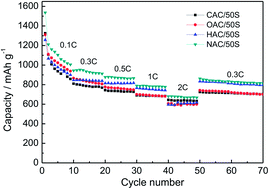Our official English website, www.x-mol.net, welcomes your
feedback! (Note: you will need to create a separate account there.)
Biomass-derived activated carbon/sulfur composites as cathode electrodes for Li–S batteries by reducing the oxygen content
RSC Advances ( IF 3.9 ) Pub Date : 2020-1-15 , DOI: 10.1039/c9ra09610h Bing Li 1 , Meng Xie 1 , Guanghai Yi 1 , Cunman Zhang 1
RSC Advances ( IF 3.9 ) Pub Date : 2020-1-15 , DOI: 10.1039/c9ra09610h Bing Li 1 , Meng Xie 1 , Guanghai Yi 1 , Cunman Zhang 1
Affiliation

|
Corncob-derived activated carbon/sulfur as the cathode electrode for lithium sulfur batteries shows a good electrochemical performance, but the capacity fades rapidly with increase of cycle time. The experimental results demonstrate that such capacity fading is closely related to oxygen content of the activated carbon matrix. To investigate the effect of oxygen content on capacity fading, four carbon matrices (CAC, OAC, HAC, NAC) with different oxygen contents but similar surface areas and pore textures were obtained through a two-step method, namely, CAC was firstly oxygenated by nitric acid and then was reduced by H2 or NH3 at high temperature. The oxygen content of CAC, OAC, HAC and NAC was about 9.49 wt%, 20.41 wt%, 4.98 wt% and 4.74 wt%, respectively. Electrodes HAC/50S (H2-treated carbon/sulfur composite with 50% sulfur) and NAC/50S with low oxygen content show a big improvement compared to the CAC/50S electrode. The HAC/50S and NAC/50S electrode deliver a high initial discharge of 1443 and 1504 mA h g−1 respectively, which remain at 756 and 799 mA h g−1 after 200 cycles at 0.3C, demonstrating a good cycle capacity and stability. It is believed that the carbon matrix with low oxygen content can effectively trap the lithium polysulfides within the carbon framework, weakening the shuttle effect and thus slowing down the capacity fade to a certain degree. Therefore, one of the effective routes to improve the electrochemical performance of Li–S batteries is to reduce the oxygen content.
中文翻译:

生物质衍生的活性炭/硫复合材料通过降低氧含量作为锂硫电池的正极
玉米芯衍生的活性炭/硫作为锂硫电池的正极显示出良好的电化学性能,但随着循环时间的增加容量迅速衰减。实验结果表明,这种容量衰减与活性炭基质的氧含量密切相关。为了研究氧含量对容量衰减的影响,通过两步法获得了四种不同氧含量但表面积和孔结构相似的碳基质(CAC、OAC、HAC、NAC),即首先将CAC氧化为硝酸,然后在高温下被H 2或NH 3还原。CAC、OAC、HAC和NAC的氧含量分别约为9.49 wt%、20.41 wt%、4.98 wt%和4.74 wt%。电极 HAC/50S (H2处理的碳/硫复合物(含硫量为 50%)和低氧含量的 NAC/50S 与 CAC/50S 电极相比有很大的改进。HAC/50S 和 NAC/50S 电极分别提供 1443 和 1504 mA hg -1的高初始放电,在 0.3C 下循环 200 次后保持在 756 和 799 mA hg -1 ,表现出良好的循环容量和稳定性。认为低氧含量的碳基体可以有效地将多硫化锂困在碳骨架内,减弱穿梭效应,从而在一定程度上减缓容量衰减。因此,提高锂硫电池电化学性能的有效途径之一是降低氧含量。
更新日期:2020-01-15
中文翻译:

生物质衍生的活性炭/硫复合材料通过降低氧含量作为锂硫电池的正极
玉米芯衍生的活性炭/硫作为锂硫电池的正极显示出良好的电化学性能,但随着循环时间的增加容量迅速衰减。实验结果表明,这种容量衰减与活性炭基质的氧含量密切相关。为了研究氧含量对容量衰减的影响,通过两步法获得了四种不同氧含量但表面积和孔结构相似的碳基质(CAC、OAC、HAC、NAC),即首先将CAC氧化为硝酸,然后在高温下被H 2或NH 3还原。CAC、OAC、HAC和NAC的氧含量分别约为9.49 wt%、20.41 wt%、4.98 wt%和4.74 wt%。电极 HAC/50S (H2处理的碳/硫复合物(含硫量为 50%)和低氧含量的 NAC/50S 与 CAC/50S 电极相比有很大的改进。HAC/50S 和 NAC/50S 电极分别提供 1443 和 1504 mA hg -1的高初始放电,在 0.3C 下循环 200 次后保持在 756 和 799 mA hg -1 ,表现出良好的循环容量和稳定性。认为低氧含量的碳基体可以有效地将多硫化锂困在碳骨架内,减弱穿梭效应,从而在一定程度上减缓容量衰减。因此,提高锂硫电池电化学性能的有效途径之一是降低氧含量。










































 京公网安备 11010802027423号
京公网安备 11010802027423号